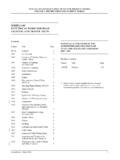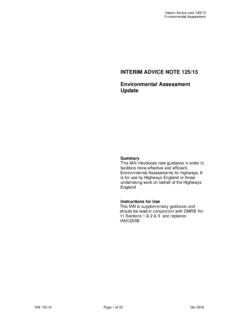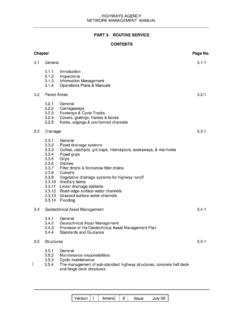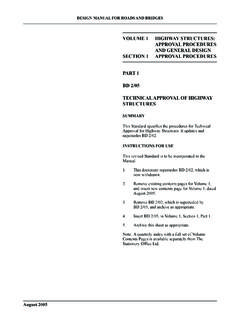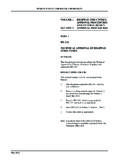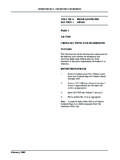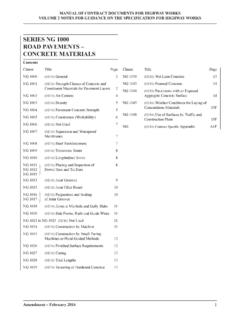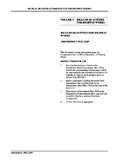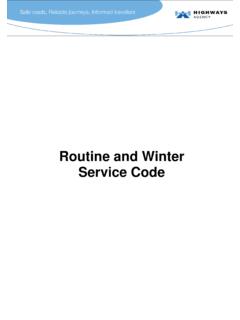Transcription of INTERIM ADVICE NOTE 190/16 Guidance on Processes for ...
1 INTERIM ADVICE Note 190/16 Guidance on Processes for managing fatigue in the Workplace IAN 190/16 Page 1 of 33 May 2016 INTERIM ADVICE NOTE 190/16 Guidance on Processes for managing fatigue in the Workplace Summary Guidance on the Processes for managing fatigue in the service provider workplace, in order to reduce risks to employees and improve the health, safety & wellbeing of employees. This IAN 190/16 provides Guidance to service providers on the Processes needed for managing fatigue in the workplace, as part of the fatigue Risk Management System. Instructions for Use This IAN 190/16 is supplementary to and should be read in conjunction with IAN 189/16 Policy on managing fatigue in the Workplace. This IAN is supplementary to (but does not replace any elements of) existing legislation and HSE Guidance documents relating to managing fatigue in the workplace. This IAN is to be implemented by all service providers no later than Friday 30 December 2016, noting that separate Guidance on managing fatigue in the workplace for Vehicle Recovery Operators is in preparation.
2 INTERIM ADVICE Note 190/16 Guidance on Processes for managing fatigue IAN 190/16 Page 2 of 33 May 2016 Table of Contents Glossary of Terms 3 1. Introduction 5 Background 5 2. Considerations for Best Practice 6 Hours of work 6 rest Periods and rest Breaks 6 Highways England Passport Scheme 7 Work Demands 7 Work Environment 8 Work Scheduling / Planning 8 Non-Work Factors 9 On call Arrangements 9 3.
3 Consultation with Employees 10 4. Contacts 11 5. Normative References 11 6. Informative References 11 Annex A - Frequently Asked Questions 13 Annex B Example Extension of hours risk assessment 17 Annex C Example Authorisation Form 19 Annex D - Example of a Timesheet incorporating requirements of a FRMS 20 Annex E - HSE fatigue and Risk Index Calculator Tool 21
4 E1. Introduction 21 E2. Limitations of the fatigue and Risk Index 21 Annex F Worked Examples 22 Summary & Background 22 Annex F1 23 Annex F2 25 Annex F3 26 Annex F4 29 Annex F5 32 INTERIM ADVICE Note 190/16 Guidance on Processes for managing fatigue IAN 190/16 Page 3 of 33 May 2016 Glossary of Terms fatigue Risk Management System The fatigue Risk Management System (FRMS) is a process which gives Guidance on how to reduce, as far as reasonably practicable, the risk of fatigue contributing to, or causing, an incident or accident. Refer to IAN 189/16, Section 2, for details. HSE fatigue and Risk Index Calculator Tool The HSE fatigue and Risk Index Calculator Tool (the HSE fatigue Tool ) evaluates the pattern of shifts in a roster to identify the risks of fatigue or error occurring as a result of how those shifts were scheduled.
5 The tool also takes account of additional factors that can cause fatigue , including commuting time, travel time, workload, level of attention required and arrangement of rest breaks. Refer to Annex E in this IAN for details. Worked examples showing how to use the HSE fatigue Tool are included at Annex F in this IAN. Employee A person employed by a service provider. An employee may be a permanent member of service provider staff, or may be a temporary member of service provider staff, or may be an agency member of service provider staff. Door to door time A period of time identified as the combined total of commuting time, travel time and working time. Commuting Time A period of time during which an employee travels from a rest location to their contracted place of work, including the return journey, regardless of whether this rest location is permanent or temporary. This type of travel is when the employee is not at the disposal of the employer.
6 Travel Time A period of time during which an employee travels whilst at the disposal of the employer, including carrying out activities or duties on behalf of the employer. This type of travel does not include Commuting Time. Working Time A period of time, inclusive of rest breaks, during which an employee is at the disposal of the employer including carrying out activities or duties on behalf of their employer. Part or all of this period may be Travel Time. Work Activities or duties carried out by an employee under the direction, responsibility and disposal of the employer. Hours of Work Actual (not rostered) time spent working at the employer s disposal, including overtime, rest days worked, paid travelling/walking time, handover/wash-up time and paid meal/ rest breaks. Place of Work Location where an employee is working at the employer s disposal. INTERIM ADVICE Note 190/16 Guidance on Processes for managing fatigue IAN 190/16 Page 4 of 33 May 2016 rest Breaks A short time of rest occurring within a shift or duty period, in accordance with the Working Time Regulations.
7 A rest break occurs during Working Time. rest Location Home or other temporary place of residence where the rest Period can be achieved, in accordance with the Working Time Regulations. rest Periods A period of time which is not Working Time, other than leave to which a worker is entitled to under the Working Time Regulations. Part of the rest Period includes Commuting Time. On Call An individual waiting to respond to an emergency call-out or answering a query from people working in the field. Roster / Working Pattern Working time schedule depicting periods of duty or leave for individuals or groups. Shift or Duty Period A period of time when an employee is at the employer s disposal and undertakes designated duties and activities. For operational staff, such periods of time at the employer s disposal normally have defined start and end times which may vary on a periodic basis in accordance with a predefined roster.
8 For non-operational staff, such periods of time at the employer s disposal may be self-determined and will include on call time when they are required to be at their employer s place of work. Working Time Regulations Refers to the Working Time Regulations 1998 and any subsequent published amendments. INTERIM ADVICE Note 190/16 Guidance on Processes for managing fatigue IAN 190/16 Page 5 of 33 May 2016 1. Introduction Background IAN 189/16 Policy on managing fatigue in the Workplace was prepared following publication of Highways England s Health and Safety 5 Year Plan in October 2015. IAN 189/16 provides policy to service providers on managing fatigue in the workplace, for all service provider employees. IAN 189/16 outlines how the management of risk associated with employee fatigue , especially with regard to night time working, very long working times, or split shift working, may be assessed using a fatigue Risk Management System (FRMS).
9 The monitoring of door to door times , working times and driving times and having suitable and sufficient mitigation measures in place to ensure employee fatigue risks are minimised. Scope This IAN 190/16 provides Guidance to service providers on the Processes needed for managing fatigue in the workplace, as part of a FRMS. This IAN 190/16 includes worked examples showing how to evaluate the suitability of different working patterns, suggested documentation to be used and a list of frequently asked questions . This IAN 190/16 is supplementary to IAN 189/16. This IAN 190/16 is supplementary to (but does not replace any elements of) existing legislation and HSE Guidance documents relating to managing fatigue in the workplace. INTERIM ADVICE Note 190/16 Guidance on Processes for managing fatigue IAN 190/16 Page 6 of 33 May 2016 2. Considerations for Best Practice Hours of work When planning works, the safest and most efficient shift patterns should be used.
10 The timing of shift patterns should take account of varying risks at different times of the day or night. For example, night shifts may mean reduced visibility and (at a specified location) may reduce the risk from the traffic flow adjacent to the working area. A suitable and sufficient risk assessment will assist in determining the pros and cons of carrying out the specified work activities at different times of the day or night. Legal requirements must be met at all times. The following recommendations will assist in minimising fatigue risk: Assess the use of shift work to minimise risk. Limit the number of consecutive night shifts to six. Allocate shift workers consecutive days off. Schedule consistent start times or where rotating rosters are used, using forward rotation for shifts (morning-afternoon-night) rather than a backward rotation (night-afternoon-morning). Identify ways to make sure shifts do not extend beyond usual finish times, for example, hold points to ensure that an activity that cannot be stopped part way through is not started if it cannot be finished within the shift, road planing and resurfacing a carriageway.
